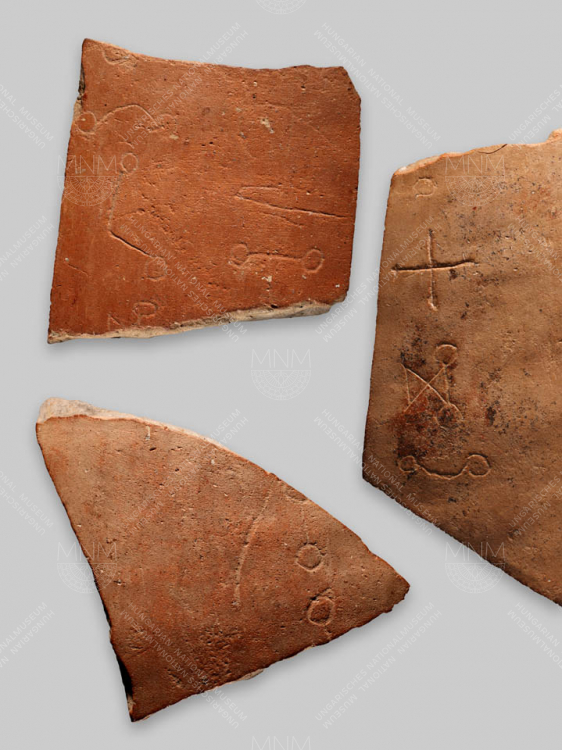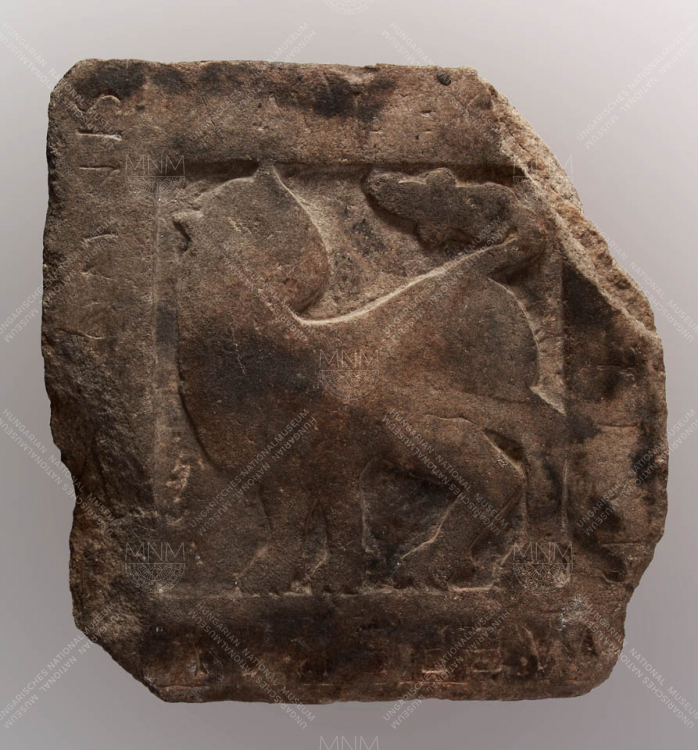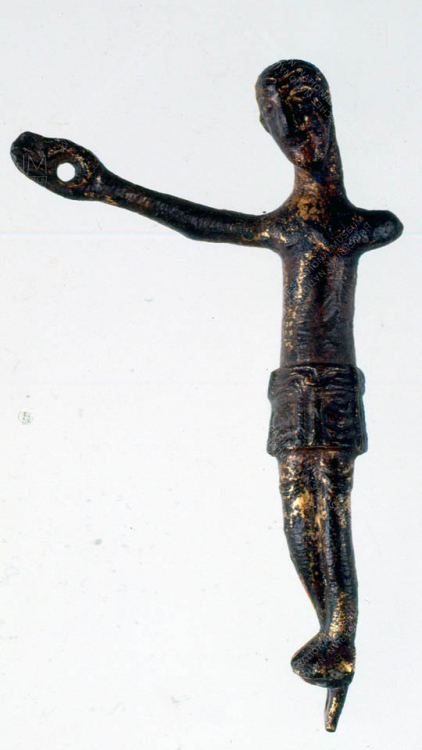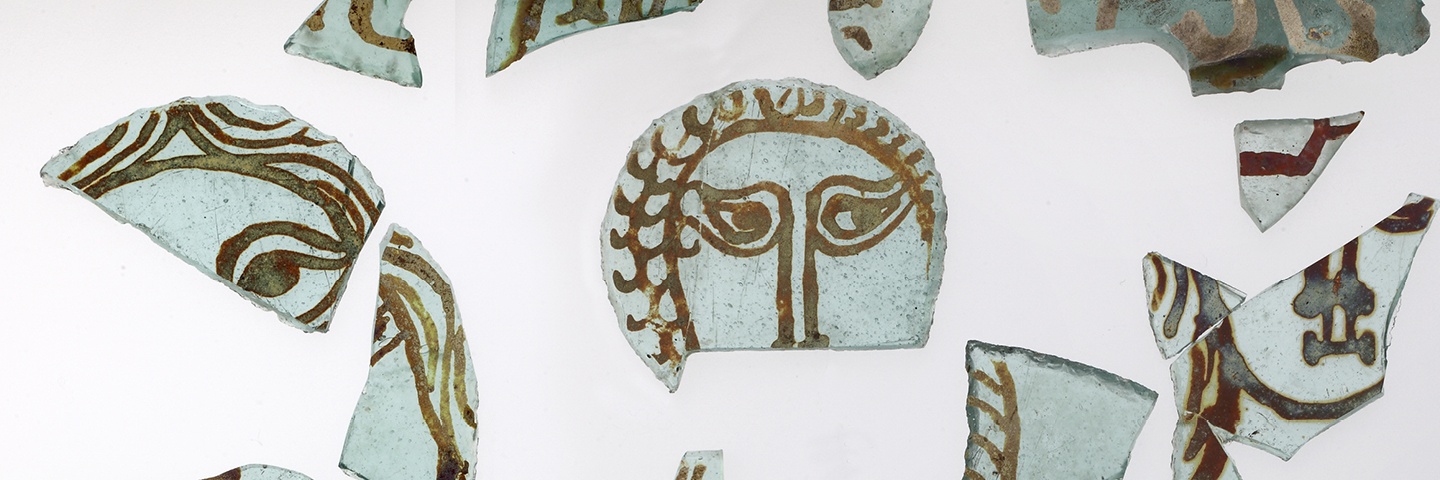
Department of Archaeology
Archaeological Department short description
This consists of finds from the 9th century to the 17th century recovered from settlements and cemeteries during regular excavations performed at a number of sites outside the village of Zalavár since 1951. The medieval centre at Zalavár-Vársziget (‘Castle Island’) was surrounded by a dense network of villages. Accordingly, the material recovered well reflects the changes that took place in the material culture of a micro-region. On the other hand, in a given period it characterises the life circumstances of members of the different social layers in the settlement network. The majority of the finds uncovered are ceramic. Numerous and various artefacts of attire (9th-century spurs, pendants, buttons, and rings; 11th–13th-century hoop jewellery and beads) from the cemeteries have entered the collection.
 5
5
BURIAL OF A YOUNG FEMALE DIGNITARY: BUTTONS, DISK FIBULA, PAIR OF EARRINGS, AND HAIRPINS
Zalavár-Vársziget, churchyard of the Hadrianus pilgrimage church, Burial 120/89. MNM 89.24.2-5.Z.
Gold, silver gilt, gilt-bronze, almandine, with coral and seashell inlay
Situated on the outer side of the chancel, the corridor crypt of the Hadrianus pilgrimage church at Zalavár-Vársziget was built in such a way that believers hoping for improvement in their fortunes or for a miraculous cure could make direct contact with Hadrianus the Martyr ‘of body incorrupt’ who was buried beneath the altar. For this reason, the leading families tried to be buried there. In one of the crypts adjoining the corridor crypt lay a young girl, the veil on whose head was held in place by gilt-bronze hairpins. Near to her ears were gold hoop earrings decorated with hollow spheres embellished with granulation. On her shoulders was a pair of hollow silver-gilt spheres with protrusions, while on her chest was a silver-gilt disk fibula decorated with an almandine along with coral and seashell.

FRAGMENT OF SILVER-PAINTED WINDOW-GLASS
Zalavár-Vársziget, Hadrianus pilgrimage church
MNM 88.40.28.Z; 88.40.29.Z; 88.42.1.Z
Glass
Fifty metres in length, Mosaburg/Zalavár’s principal church was built in the second half of the 850s, in the geometrical centre of Vársziget (‘Castle Island’). Supplied with a chancel which was semicircular at its eastern end, the three-nave basilica, which had a corridor crypt at its eastern end and a monastery complex at its western end, served as a pilgrimage church and, for a short time, as a bishop’s seat also.
The windows in the area of the church’s chancel and corridor crypt featured glass panels consisting of small panes set in lead that were painted in sea blue, bluish green, blue, emerald green, olive green, brownish purple, and yellow; and, using a technology developed in the Eastern Mediteranean region, in copper red and silver yellow also.

FRAGMENTS OF THE SIDE OF A POLISHED FLASK WITH ROUND GLAGOLITIC LETTERING
Zalavár-Vársziget, environs of the Hadrianus pilgrimage church
MNM 2002.1.1209.1.Z; 2011.1.261.24.Z; 2002.1.1.1159.1.Z.
Clay
The tableware used during meals taken by members of the elite at Zalavár-Vársziget was made on a hand-turned potter’s wheel using clay that had been carefully washed. The pieces recovered are in most cases carefully polished and fired to a golden brown colour. They are mainly from flasks, jugs with one or two handles, amphoras for table use, ‘soup tureens’, flat and deep bowls, cups, beakers, and lids. The surfaces of the more decorated vessels sometimes have lettering scratched on. The fragments bearing Glagolitic letters are especially noteworthy; they are reminders of the work performed in Mosaburg by Constantinus and Methodius. The following letters can be made out: a (Az), g (Glagoli), d (Dobro), v (Vedi), i (Izhe), o (On), f (Fita), ja (Yat), and also the cross used as a mark between words.

FLAGSTONE WITH A DEPICTION OF A LION
Zalavár-Vársziget (scattered find), Hadrianus pilgrimage church (?)
MNM 56.28.1.A
Marble
On the flagstone, which is square in shape and very worn, there is a depiction of a standing lion that is looking to the left. Its tail ends in three tassels. The broad circumscription can be read only in parts: [S]VMLEO …/…TISD/.MEFER.V./…OMNIS.
The flagstone was part of the interior of the Monastery of St. Hadrianus, which was founded in 1019. Where it was originally in the monastery is not known. Similar pieces have been found mostly in the part of the church that led to the chancel, which adjoined the middle nave.

BODY OF CHRIST
Zalavár-Récéskút
MNM 63.69.A
Gilded bronze
The left arm of the gilded bronze Body of Christ has broken off and the body has become misshapen. The artefact was found during the excavation of late medieval post-holes, during the excavation of a church. The damage to the artefact was caused by the knocking in of the post. This Body of Christ figure indicates that the building, which was put up in the 9th century, was still being used as a church in the Arpadian era.
BURIAL OF A YOUNG FEMALE DIGNITARY: BUTTONS, DISK FIBULA, PAIR OF EARRINGS, AND HAIRPINS
Zalavár-Vársziget, churchyard of the Hadrianus pilgrimage church, Burial 120/89. MNM 89.24.2-5.Z.
Gold, silver gilt, gilt-bronze, almandine, with coral and seashell inlay
Situated on the outer side of the chancel, the corridor crypt of the Hadrianus pilgrimage church at Zalavár-Vársziget was built in such a way that believers hoping for improvement in their fortunes or for a miraculous cure could make direct contact with Hadrianus the Martyr ‘of body incorrupt’ who was buried beneath the altar. For this reason, the leading families tried to be buried there. In one of the crypts adjoining the corridor crypt lay a young girl, the veil on whose head was held in place by gilt-bronze hairpins. Near to her ears were gold hoop earrings decorated with hollow spheres embellished with granulation. On her shoulders was a pair of hollow silver-gilt spheres with protrusions, while on her chest was a silver-gilt disk fibula decorated with an almandine along with coral and seashell.

FRAGMENT OF SILVER-PAINTED WINDOW-GLASS
Zalavár-Vársziget, Hadrianus pilgrimage church
MNM 88.40.28.Z; 88.40.29.Z; 88.42.1.Z
Glass
Fifty metres in length, Mosaburg/Zalavár’s principal church was built in the second half of the 850s, in the geometrical centre of Vársziget (‘Castle Island’). Supplied with a chancel which was semicircular at its eastern end, the three-nave basilica, which had a corridor crypt at its eastern end and a monastery complex at its western end, served as a pilgrimage church and, for a short time, as a bishop’s seat also.
The windows in the area of the church’s chancel and corridor crypt featured glass panels consisting of small panes set in lead that were painted in sea blue, bluish green, blue, emerald green, olive green, brownish purple, and yellow; and, using a technology developed in the Eastern Mediteranean region, in copper red and silver yellow also.

FRAGMENTS OF THE SIDE OF A POLISHED FLASK WITH ROUND GLAGOLITIC LETTERING
Zalavár-Vársziget, environs of the Hadrianus pilgrimage church
MNM 2002.1.1209.1.Z; 2011.1.261.24.Z; 2002.1.1.1159.1.Z.
Clay
The tableware used during meals taken by members of the elite at Zalavár-Vársziget was made on a hand-turned potter’s wheel using clay that had been carefully washed. The pieces recovered are in most cases carefully polished and fired to a golden brown colour. They are mainly from flasks, jugs with one or two handles, amphoras for table use, ‘soup tureens’, flat and deep bowls, cups, beakers, and lids. The surfaces of the more decorated vessels sometimes have lettering scratched on. The fragments bearing Glagolitic letters are especially noteworthy; they are reminders of the work performed in Mosaburg by Constantinus and Methodius. The following letters can be made out: a (Az), g (Glagoli), d (Dobro), v (Vedi), i (Izhe), o (On), f (Fita), ja (Yat), and also the cross used as a mark between words.

FLAGSTONE WITH A DEPICTION OF A LION
Zalavár-Vársziget (scattered find), Hadrianus pilgrimage church (?)
MNM 56.28.1.A
Marble
On the flagstone, which is square in shape and very worn, there is a depiction of a standing lion that is looking to the left. Its tail ends in three tassels. The broad circumscription can be read only in parts: [S]VMLEO …/…TISD/.MEFER.V./…OMNIS.
The flagstone was part of the interior of the Monastery of St. Hadrianus, which was founded in 1019. Where it was originally in the monastery is not known. Similar pieces have been found mostly in the part of the church that led to the chancel, which adjoined the middle nave.

BODY OF CHRIST
Zalavár-Récéskút
MNM 63.69.A
Gilded bronze
The left arm of the gilded bronze Body of Christ has broken off and the body has become misshapen. The artefact was found during the excavation of late medieval post-holes, during the excavation of a church. The damage to the artefact was caused by the knocking in of the post. This Body of Christ figure indicates that the building, which was put up in the 9th century, was still being used as a church in the Arpadian era.









